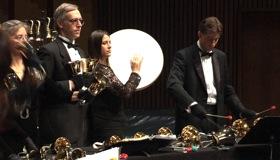Into the Woods and Beyond Broadway
It was a discombobulating moment Friday night at the premiere of Diablo Theatre Company's production of the Stephen Sondheim-James Lapine Into the Woods in Walnut Creek. No, I don't mean the accident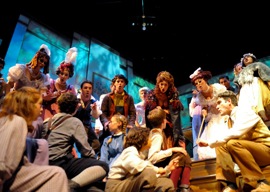 (more about that later), but rather a sudden realization about the music.
(more about that later), but rather a sudden realization about the music. As the Witch sang the heartbreaking "Stay with me" —
- Don't you know what's out there in the world?
Someone has to shield you from the world.
Stay with me.
Princes wait there in the world, it's true.
Princes, yes, but wolves and humans, too.
Stay at home.
I am home.
I heard chord progressions and the movement of the musical line that seemed unfamiliar ... and fascinating. Why the surprise? Because I've been listening to Into the Woods since its San Diego pre-Broadway premiere in 1986, I know and can sing (in the shower, at least) every word of those sublime lyrics. So, again, why the surprise?
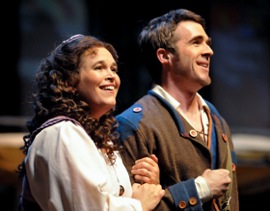
The answer is that great music can remain forever fresh, revealing new riches. And Sondheim (stupidly accused in the distant past as one who "cannot write a tune") has created some musical masterpieces, not just clever Broadway musicals.
I have overcome objections to my regard for him as one of the greatest American opera composers. One of those objecting was Sondheim himself. I had a rare chance of challenging the maestro face to face at a symposium in San Francisco as to why he insists that his works are not "operas," but "musicals."
After some hesitation, he said the genre is determined by the venue: Opera is performed in opera houses, while musicals are performed on Broadway and in theaters. There came my moment of triumph, using his own argument, and pointing to A Little Night Music performed at the New York City Opera, Houston Grand Opera, and elsewhere; Sweeney Todd is performed in numerous opera houses, and how the musically through-composed (no spoken dialogue) grand opera Passion should — and will — be a staple of, yes, opera houses.
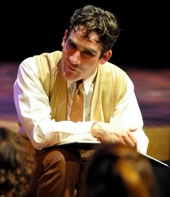
Sondheim refused to capitulate, but I believed it then and am absolutely certain now that most of his "musicals" are operas, true and blue.
Now, thanks to Diablo and the outstanding director Ryan Mark Weible, I have another argument in favor of my theory. Almost invariably musicals are produced in their original form; operas — as we know, often to our regret — are constantly played with by stage directors. In the worst possible outcome, Eurotrash gore buries the work completely, but the fact that operas both challenge and survive interpreters is an important characteristic.
In the Diablo production, Weible took Sondheim's fractured fairy tales from the antediluvian times of the Grimm Brothers' imagination, and transplanted the action firmly and safely in a 1930s orphanage, run by a caring headmaster, the very opposite of Annie's Miss Hannigan. It takes an opera's depth for a caring, imaginative restaging to make this Into the Woods even better. Of course, Weible's idea alone was no magic wand against failure; his direction, the cast's excellence, the performance of Cheryl Yee Glass' 11-piece orchestra helped this work to a great new realization.
There were some unique extras to the premiere in Lesher Center beyond the orphanage setting — gremlins aplenty, and a virtual showstopper, but not in a good way. Beyond and above it all: The show did go on, and it succeeded.
"This is an opening night you will never forget," Diablo Theatre Company Artistic Director Daren Carollo told the audience. It was not a preshow prediction or postshow crowing. It came after the intermission, a good spin on a scary accident. "Never" is a long time, but Carollo may yet be right. It happened when Jack DeRieux, a retired drama teacher, in the role of the Mysterious Man, tried to squeeze through a small structure in the set, when it collapsed, burying him under the rubble. There was a great collective gasp, then an actor and a stagehand pulled DeRieux out from the box and carried him offstage.
Meanwhile, other than DeRieux's line, nothing was missed, and the play continued smoothly. About 10 minutes later, when the Mysterious Man has another appearance, DeRieux actually hobbled in and — after a round of applause — delivered his line. In the intermission, DeRieux was taken to Kaiser (no broken bones found), Carollo delivered his remarks, and the indefatigable Joel Roster took on DeRieux's role in the second act, changing back and forth almost as much as the Witch.
Through it all, and fighting electronics heroically, Glass' band delivered an admirable performance. They even made what I have always thought to be an overlong and dragging second act, with its unnecessary reprises ("No One Is Alone ... Alone ... Alone") work just fine.
You may not have another performance with the opening-night drama, but the Diablo production is highly recommended even when all goes well. It's running through June 20.
Sonos Rings Birthday Bells
James Meredith's Sonos bellringers are celebrating their 20th anniversary in a big way, including a party to which everyone is invited — as long you as you make a free reservation by calling (510) 531-4780.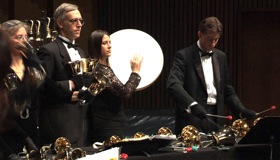
Besides food, drinks, and merrymaking with the Sonos players, who will also give a free concert, the "20/20 Vision: Ringing on the Edge" party will have the premiere screening of Ringing Down, a film about Sonos by Oscar-winning videographer Eric Thiermann and playwright Alexsandra Wolska.
Structured as "a day in a life of a bell composer," the film follows a journey from a Romanian orphanage through a Greek carnival on the island of Skiros to the royal castle in Krakow, where one of the largest bells in the world tolls on All Saint’s Day.
The event begins at 4 p.m., on Sunday, June 13, in the Theater of Auctions by the Bay, at the former Alameda Naval Station.
Sonos had some notable "firsts," including the commissioning and performance (with Michael Morgan and the Oakland East Bay Symphony) of the first major work for handbells and orchestra, William Ludtke's Suite for Handbells and Orchestra, as well as commissions of Hell's Belles from Libby Larsen, and Daniel Feinsmith's Yahweh from the Kronos Quartet.
Beyond Ringing Down, there is the release of Sonos' Ringing Up, a DVD of a live program of Bach, MacDowell, Ives, Gershwin, and works by Meredith.
Meredith explains the use of "up" and "down":
"Ringing up" is the description of the way Americans ring bells as opposed to the English, who leave them down on the table and ring them backward (they don't think of it this way!) as they pick them up.There will be another 20th anniversary concert, a free one, at 4 p.m. on July 10 at the Lafayette-Orinda Presbyterian Church."Ringing down" is what firefighters call the ceremony they have when honoring a fallen colleague. They ring a bell three times. We interviewed the chief of the Menlo Park Fire Department when we used their structural collapse training site to shoot Smirti, which is a musical response to 9/11 with cellist Emil Miland. The chief had been at the cleanup after the McVeigh bombing in Oaklahoma City and the destruction of the Twin Towers in New York. A very moving interview.
Meredith does a great deal of good work besides Sonos, teaching (UC Berkeley, San José State University), and working with the vital Young Musicians Program as the voice faculty. Among singers he has accompanied and with whom he has formed a "musical partnership": Frederica von Stade and Olivia Stapp.
George Thomson's Journey to the North
In a sense, four music directors are leaving the Bay Area all at once, as George Thomson moves to Salem, Oregon, next week to take up a teaching position with the Salem-Keizer public school system there.
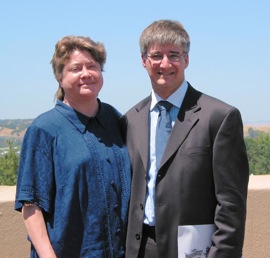
Thomson is music director of the Virtuoso Program at San Domenico School in San Anselmo, artistic director of the Marin Symphony Youth Programs, conductor of the Marin Symphony Youth Orchestra. And he serves as interim music director of the Santa Rosa Symphony's Young People's Chamber Orchestra.
He is leaving all those positions, although joining the faculty of the Rocky Ridge Music Center in Estes Park, Colorado, and conducting the Young Artists Seminar Orchestra in the summer.
Formerly music director of Oakland's Prometheus Symphony, Thomson was a 13-year veteran of the Berkeley Symphony, where he conducted a subscription program as well as several rehearsals each season in the absence of Music Director Kent Nagano, and directed the Under Construction series of new-music events.
Making the loss of Thomson for the Bay Area even worse is the connubial move to Oregon by violist and superb music writer Michelle Dulak Thomson, whose reports have graced these pages for almost the entire history of Classical Voice.
Tosca — from Opera to Café to Musical
"Conjuring a world in which love, betrayal, and hope emerge from the shadows and disappear with the clink of a glass" goes the advertising for The Tosca Project, an unusual collaboration between artists of the American Conservatory Theater and the San Francisco Ballet.
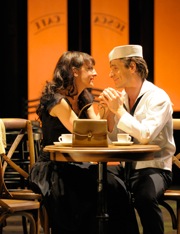
Photos by Kevin Berne
Café Tosca occupies a special place in the history of San Francisco's North Beach, with its combination of Italian café ambiance, opera — live and recorded — and as a social fulcrum.
Since its establishment in 1917, surviving through Prohibition, and the ups and downs of The City, the café has been regularly populated by politicians, journalists, writers, movie stars, dancers, and an increasingly larger proportion of tourists. In modern times, it's been owned by Jeannette Etheredge, of the Nureyev Foundation.
Café Tosca has served as "typical San Francisco venue" in a half dozen films, including Basic Instinct and Twisted.
Almost four years ago, A.C.T. Artistic Director Carey Perloff and San Francisco Ballet dancer and choreographer Val Caniparoli started working on a show about the café, workshopping a musical revue to invoke the spirit of the place and to pay tribute to it.
The result is The Tosca Project, originally called "a movement-theater workshop presentation." It is now more of one piece, an integrated work, with a story linking individual musical and dance numbers.
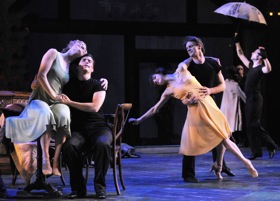
With music from Puccini (natch!) to Hendrix and pretty much everything in-between, The Tosca Project is performed by dancers Pascal Molat, Lorena Feijoo, Sabina Allemann, along with actors Peter Anderson, Rachel Ticotin, Gregory Wallace, and Jack Willis.
"We celebrate the Café as a metaphor for all those magical bars around the world in which the ghosts of a million encounters remain present in the air," says Perloff. "It is a unique collaboration between some of the best Bay Area artists and the city we love, offered as a valentine to our extraordinary audience."
Caniparoli adds: "When Carey and I first started discussing the project, we knew that this was going to be an incredible collaboration, featuring artists from different disciplines, backgrounds, and styles. I have loved seeing these completely different artists working in a room together."
Playing in Tune: the Madness of It All
... if you start with a C at the bottom of a piano keyboard and tune a series of 12 perfect 3:2 fifths up to the top, you discover that where you expect to have returned to a perfect high C, that C is overshot, intolerably out of tune. In other words, nature's math doesn't add up.(I suppose there has been less of an impact on women because, as a rule, they are less obsessive.)A series of perfect intervals doesn't end at a perfect interval from where you started. If you tune three perfect 5:4 major thirds, it should logically add up to an octave, but it doesn't; the result is egregiously flat. It is this innate irreconcilability of pitch that, through the centuries, has driven men mad.
The quote is from an intriguing article by Jan Swafford in Slate, "The Centuries-old Struggle to Play in Tune." It is a thorough (but lighthearted) analysis of How Equal Temperament Ruined Harmony (and Why You Should Care), by Professor Ross W. Duffin.
It's hard to summarize briefly the central issue, but this comes close:
... in tuning keyboards and fretted instruments, you have to screw around with the intervals in order to fit the necessary notes into an octave. In other words, as we say, you have to temper pure intervals, nudge them up or down a hair in some systematic way. Otherwise, you get chaos.Have fun getting in this deeper, but be warned that there is virtually no bottom to it all.The business of adapting tuning to nature's messy math is called temperament. And now we're halfway to understanding The Well-Tempered Clavier: It has to do with the art and science of keyboard tuning.
From Voodoo to Celebration of Mexico's Bicentennial
Throughout this month, the 32nd San Francisco Ethnic Dance Festival unfolds in the Palace of Fine Arts, featuring four pairs of programs presenting 37 Bay Area dance companies and their 600 dancers.
From cultures as different as those of the Congo, Afghanistan, China, and Mexico come 36 dances, 26 of them world premieres.

Among first-time participants in the festival is Djenane Saint Juste, artistic director of the Afoutayi Dance Company of San Francisco. He is from Haiti and his dancing career began with participation in that country's widespread voodoo culture, as he explains:
I am continuing my family tradition to keep the voodoo in my life because this tradition is part of my blood, my heart, and my soul. My grandmother was a mambo and a queen of Rara in Lagonave, Haiti. She taught my mother all beauty of the dances, singing, drumming, and religious practices — and I learned from my mother, also a mambo and a famous dancer.Mexico occupies a special place this year, with a festival tribute to the country's bicentennial celebration.
"Over the past three decades of the festival, the Mexican folkloric dance community has been one of the most inspiring to present on stage," says Festival Executive Director Julie Mushet. "To bring dancers together for this year’s Mexican Bicentennial Tribute from six outstanding companies is a very special opportunity and thrilling collaboration."
One of those companies is the Ballet Folklorico Mexicano de Carlos Moreno of Oakland, participating in the festival for the fifth time. Moreno says the company was founded by his father before he was born, his mother is making the traditional costumes.
I grew up watching many groups from Mexico perform and traveled throughout Mexico with my father, learning the many regional dances and experiencing life in that beautiful country. Folklorico is my life, my love, and I do not know life without it.From another part of the world comes the very different cultural tradition represented by Fua Dia Congo of Oakland. One of the festival's founding companies, with a dozen appearances over the years, the troupe is directed by Muisi-kongo S. Malonga, who says:
Traditional Congolese music and dance is the primary vehicle through which I am able to stay actively connected to my cultural heritage, share valuable cultural information with others, and, more personally, build upon the works and safeguard the memory of my father — Fua Dia Congo founder Malonga Casquelourd.Representing modern Indian dance influenced by the Bollywood musical/film genre. Ishika Seth is choreographer, instructor, and dancer with the Mona Sampath Dance Company of Milpitas.
"I was born and raised in India where I studied Indian contemporary dance, Mayurbhanj Chhau and yoga," says Seth, who came to the U.S. to study modern dance. "I discovered Mona Sampath's style of Bollywood in the Bay Area and found a unique blend of East and West, stemming from a cultural place but evolving into a global and contemporary dance form."
'Most Popular' Operas
For those championing contemporary and American operas, this must have been a joyful occasion, however briefly.
G. Schirmer Publishers, which commendably represents many American composers, said in its June newsletter that it is "pleased to announce that OPERA America has identified Gian Carlo Menotti’s Amahl and the Night Visitors as being the most performed opera [in the 2008-2009 season] in North America among works produced by OPERA America Members since 1991."
"American" Menotti over Verdi, Puccini, and all those Eye-talians — Is it possible? No, it turned out to be a wishful misstatement. "In North America" rather than "North American" is just enough of a "slight adjustment" to turn things on their head.
By now, if you look on the Schirmer Web site, you will find the correct context from OPERA America: Amahl and the following operas written by American composers constitute that particular Top Ten, not of those performed in the U.S. and Canada.
George Gershwin's Porgy and Bess, Carlisle Floyd's Susannah, Leonard Bernstein's Candide [no West Side Story?], Stephen Sondheim's A Little Night Music and Sweeney Todd, Stravinsky's The Rake's Progress, Mark Adamo's Little Women, Douglas Moore's The Ballad of Baby Doe, and Frederick Loewe's My Fair Lady.
As to the grand old warhorses, this is the Top Ten list:
Puccini's La bohème, Tosca, and Madama Butterfly; Verdi’s La traviata; Rossini's The Barber of Seville; Mozart's The Magic Flute; Bizet's Carmen; Donizetti's The Elixir of Love and Lucia di Lammermoor; and Mascagni's Cavalleria rusticana.
Medici's New Riches
Of all the Thomas Quasthoff Winterreise performances (I lost count), this new one, with Daniel Barenboim, is among the best, and there is a free sample with preview.
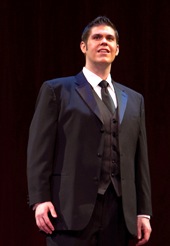
There was a live telecast last week from the opening of the St. Denis Festival, Riccardo Muti conducting Orchestre National de France in Schubert and Cherubini (Requiem in memory of Louis XVI of France), with soprano Elin Rombo, tenor Topi Lehtipuu, and bass Luca Pisaroni (SFO's past Masetto, future [Le Nozze] Figaro). The video is still on the Medici.tv site.
Also, the telecast of last month's Operalia finals from La Scala is still available free, with red-hot performances by young talent.
Sopranos Sonya Yoncheva, Dinara Alieva, and Rosa Feola; tenors Stefan Pop, Giordano Luca, (Merola alum) Nathaniel Peake; and basses Ievgen Orlov and Chae Jun Lim are all heading to top opera houses around the world. Lim's voice still needs seasoning/maturing, but he is already an exciting singer; Alieva is the complete package — those two performances alone make this video a must-see.
(Too) Late News: The Residents

Sarah Cahill, whose timing in performance is flawless, was lamentably late in calling attention to an important event the day before it happened.
Still, even without publicity here or anywhere else, nearly a thousand fans turned out for The Residents last weekend at the Berkeley Art Museum. Says Cahill: "Not sure how they all found out about it, except that some drove from Portland and L.A. for the occasion."
Not from personal experience, alas, this is the description of The Residents:
An American avant-garde music and visual arts group, who have been active since 1969. Their first official release under the name of "The Residents" was in 1972, and since then the band has gone on to release over 60 albums, numerous music videos and short films, three CD-ROM projects, 10 DVDs, and have undertaken seven major world tours.Throughout the group's existence, the individual members have ostensibly attempted to conceal their identities from the public, and much public speculation and rumor has focused on this aspect of the group. In public, the group appears silent and costumed, often wearing eyeball helmets, top hats, and tuxedos — now recognized as their signature iconography. Their albums are often complex conceptual pieces, composed around a theme, theory or plot, and are noted for surrealistic lyrics and disregard for standard Western pop music composition.
Despite polarizing critical opinion and mostly eluding mainstream recognition, The Residents have maintained a dedicated fan following throughout the length of their career, and have remained active throughout. Noted fans include Simpsons creator Matt Groening, comedian Penn Jillette, and musicians such as Primus, The KLF, They Might Be Giants, Animal Collective, Mr. Bungle, Burial, TISM, and ism.
World Cup Craze Has Its Musical Moments

With a measly 370,000 visitors expected in South Africa for World Cup 2010, why should you care? Because the population of the world is 6.8 billion, and yet the cumulative global audience for the 2006 Cup is 26.3 billion, and a slightly larger figure is expected this month. No other event has numbers like that, although when — not if — China makes it into the Cup, expect the figures to swell by a few more billions.
So, like it or not, attention is to be paid to the event, taking place in 10 South African cities, June 6-30.
Check the great World Cup Song. Remember the opportunity to hear national anthems everywhere. And, although the original Three Tenors no longer grace the proceedings, Ziggy Marley will do his thing.
As for football itself, everything you ever wanted to know about the World Cup schedule is online. Good luck catching the games played at 4:30 a.m. Pacific time.

